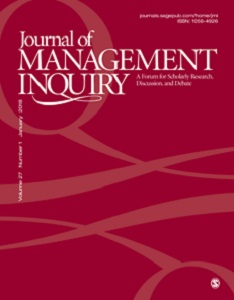Academic articles
Practitioner articles
Working papers
Books
Book chapters
Case studies
Other publications
Subject(s)
Marketing
Keyword(s)
inspirational appeals, personal selling, customer emotions, influence tactics
JEL Code(s)
M310
In personal selling, the inspirational appeal (IA) is a widely promoted tactic that aims at stimulating customers’ values and ideals, thereby evoking emotions and arousing their enthusiasm for a product. However, whether IAs in fact improve or undermine salespeople’s success in sales talks remains controversial. Therefore, the present study examines consequences and key contingencies of IAs in customer–salesperson interactions in a retailing context, using multi-source data from several retailing industries for three quantitative studies, comprising a total sample of 590 customer and 174 salesperson responses. Drawing on the Multiple Inferences Model (MIM), the authors show that an IA is likely to drive the customer’s inference that the salesperson holds ulterior motives. IAs seem to be particularly detrimental for salespeople with a lack of customer orientation. Beyond expanding research on influence tactics and the ambivalent role of IAs in retailing interactions, these findings can guide practitioners about when to refrain from using an IA.
Volume
38
Journal Pages
323–343
ISSN (Online)
1557–7813
ISSN (Print)
0885–3134
Subject(s)
Entrepreneurship
Keyword(s)
Entrepreneurial firms, human capital, innovative performance, motives, start-up joiners
We examine whether start-ups attract employees with different pecuniary and non-pecuniary motives than small or large established firms. We then explore whether such differences in employee motives may lead to differences in innovative performance across firm types. Using data on more than 10,000 U.S. R&D employees, we find that start-up employees (“joiners”) place lower importance on job security and salary but greater importance on independence and responsibility. Start-up employees have higher patent output than employees in small and large established firms, and this difference is partly mediated by employee motives - especially joiners’ greater willingness to bear risk. We discuss implications for research as well as for managers and policy makers concerned with the supply of human capital to entrepreneurship and innovation.
Copyright © 2017 Strategic Management Society
Volume
12
Journal Pages
423–454
Subject(s)
Strategy and general management; Technology, R&D management
Keyword(s)
Inventor mobility, alliance formation, interfirm collaboration, technological capabilities, pharmaceuticals
We link the hiring of R&D scientists from industry competitors to the subsequent formation of collaborative agreements, namely technology-oriented alliances. By transferring technological knowledge as well as cognitive elements to the hiring firm, mobile inventors foster the alignment of decision frames applied by potential alliance partners in the process of alliance formation thereby making collaboration more likely. Using data on inventor mobility and alliance formation amongst 42 global pharmaceutical firms over 16 years, we show that inventor mobility is positively associated with the likelihood of alliance formation in periods following inventor movements. This relationship becomes more pronounced if these employees bring additional knowledge about their prior firm’s technological capabilities and for alliances aimed at technology development rather than for agreements related to technology transfer. It is weakened, however, if the focal firm is already familiar with the competitor’s technological capabilities. By revealing these relationships, our study contributes to research on alliance formation, employee mobility, and organizational frames.
With permission of the Academy of Management
Volume
61
Journal Pages
2026–2052
Subject(s)
Economics, politics and business environment; Information technology and systems; Technology, R&D management
Keyword(s)
Internet access market, access regulation, investment, infrastructure, Next Generation Networks, broadband, telecom, cable operators and EU regulatory framework
JEL Code(s)
L96, L51
In this paper, we study how the coexistence of access regulations for legacy (copper) and fiber networks shapes the incentives to invest in fiber-based network infrastructures. To this end, we first develop a theoretical model that extends the existing literature by, among other things, considering alternative firms with proprietary legacy network (e.g., cable operators) and the presence of asymmetric mandated access to networks. In the empirical part, we test the theoretical predictions using a novel panel data from 27 EU member states pertaining to the last decade. Our main finding is that, in line with the theoretical results, stricter access regulations (i.e., a decrease in access price to legacy network and the adoption of fiber regulation) decrease the incumbent operators’ fiber investments. The estimated magnitude of these effects is economically significant. On the other hand, cable operators, who are responsible for the largest share of investments in fiber, are not affected by access regulation. Our paper thus provides policy insights for the on-going revision of the EU regulation framework for the electronic communications industry.
With permission of Elsevier
Volume
61
Journal Pages
613–652
Subject(s)
Economics, politics and business environment; Finance, accounting and corporate governance
Keyword(s)
Credit shocks, financial crisis, labor demand, employment, wages
JEL Code(s)
D92, G01, G21, J23, J31
We study the impact of exogenous funding shocks to German savings banks during the U.S. subprime mortgage crisis on the labor decisions of 30,000+ private and public firms in Germany. We find that firms with credit relationships with affected banks experience a significant decline in labor demand relative to firms with credit relationships with healthy banks, manifested in a simultaneous reduction in firm‐level employment and average wages. The employment effect is more pronounced in larger firms, while the wage effect is stronger in smaller firms. Both employment and wages go back to pre‐shock levels three years after the shock.
With permission of Elsevier
Volume
36
Journal Pages
16–27
Subject(s)
Strategy and general management
Keyword(s)
Status, competition, tournaments
Merton often envisioned status growth as a process of stepping across a boundary between one status grade and another more elite status grade. Such boundaries include the border between graduate school and a top academic department that young researchers try to traverse, or the frontier between scientists outside the French Academy and scientists inside the French Academy. As it is now common to measure status continuously using network data, the behavioral ramifications of status boundaries have been understudied in recent research. In this essay, we focus on competitive behaviors that emerge near a status boundary because of the desirability - as well as the “double injustice” - of the Matthew effect. Offering insights for future research, we discuss how these competitive behaviors are likely to delay, or even derail, status growth for those who are near a status boundary.
With permission of SAGE Publishing
Volume
27
Journal Pages
378–381
ISSN (Online)
15526542
ISSN (Print)
10564926
Subject(s)
Human resources management/organizational behavior
Keyword(s)
Anchor precision, negotiation entry, barriers-to-entry, first offers, social attribution, decision making
Precise first offers strongly anchor negotiation outcomes. This precision advantage has been previously documented only when the parties were already engaged in a negotiation. We introduce the concept of negotiation entry, i.e., the decision to enter a negotiation with a particular party. We predict that precise prices create barriers-to-entry, reducing a counterpart’s likelihood of entering a negotiation. Six studies (N=1,580) and one archival analysis of real estate sector data (N=11,214) support our barrier-to-entry prediction: Potential negotiators were less likely to enter a negotiation with precise versus round first offers. Using both statistical mediation and experimental-causal-chain analyses, we establish that perceptions of offer maker inflexibility underlie the precision barrier. Furthermore, we demonstrate that this inflexibility mechanism of precision is distinct from the mechanism (being offended) that creates barriers-to-entry for extreme first offers. The discussion theoretically integrates research on first-offer precision and extremity by offering the Precision-Extremity Model of First Offers.
With permission of Elsevier
Volume
148
Journal Pages
87–100
Subject(s)
Human resources management/organizational behavior
Keyword(s)
Self-confidence appearance, gender, job performance, prosocial orientation, organizational influence
Appearing self-confident is instrumental for progressing at work. However, little is known about what makes individuals appear self-confident at work. We draw on attribution and social perceptions literatures to theorize about both antecedents and consequences of appearing self-confident for men and women in male-dominated professions. We suggest that performance is one determinant of whether individuals are seen as confident at work, and that this effect is moderated by gender. We further propose that self-confidence appearance increases the extent to which individuals exert influence in their organizations. However, for women, appearing self-confident is not enough to gain influence. In contrast to men, women in addition are “required” to be prosocially oriented. Multisource, time-lag data from a technological company showed that performance had a positive effect on self-confidence appearance for both men and women. However, the effect of self-confidence appearance on organizational influence was moderated by gender and prosocial orientation, as predicted. Our results show that through self-confidence appearance, job performance directly enables men to exert influence in their organizations. In contrast, high performing women gain influence only when self-confidence appearance is coupled with prosocial orientation. We discuss the implications of our results for gender equality, leadership, and social perceptions.
© 2017 Wiley Periodicals, Inc.
Volume
57
Journal Pages
839–854
Subject(s)
Finance, accounting and corporate governance
Keyword(s)
Bank competition, microfinance, microcredit, microbank, loan rates, information dispersion, PAR, portfolio quality
JEL Code(s)
D4, G21, L1, O1
We study the effects of competition on loan rates and portfolio-at-risk in microcredit markets using a new database from rating agencies, covering 379 microbanks located in 67 countries between 2002 and 2008. Our study reveals different competitive effects in nonprofit and for-profit microbanks. We find that for-profit microbanks charge significantly lower rates and exhibit improved portfolio-at-risk in less concentrated markets. In particular, the effect of concentration on loan rates is nearly three times the one reported in previous studies in banking. In contrast, nonprofit microbanks are relatively insensitive to changes in concentration. We control for interest rate ceilings, which very significantly reduce rates in for-profit microbanks. However, our study also uncovers a competitive interplay between for-profit and nonprofit microbanks. In particular, the PAR of nonprofit microbanks deteriorates when the proportion of profit-oriented microbanks increases. Finally, we find evidence consistent with dispersion of borrower-specific information among competing microbanks in the for-profit sector, even after controlling for the presence of credit registries.
Volume
50
Journal Pages
893–937
Subject(s)
Human resources management/organizational behavior
Keyword(s)
Crowdsourcing science, reproducibility
The widespread replication of research findings in independent laboratories prior to publication is suggested as a complement to traditional replication approaches. The pre-publication independent replication approach further addresses three key concerns from replication skeptics by systematically taking context into account, reducing reputational costs for original authors and replicators, and increasing the theoretical value of failed replications.
© Cambridge University Press 2018
Volume
41
ISSN (Online)
1469-1825
ISSN (Print)
0140-525X


